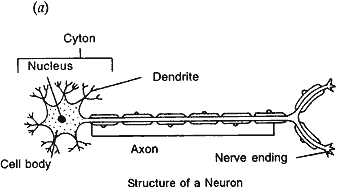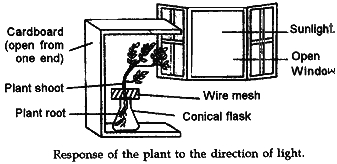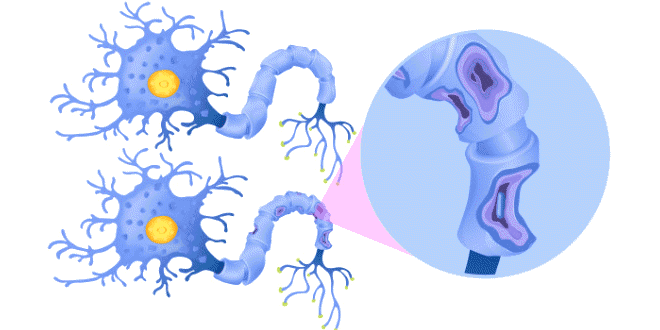Question: Design an experiment to demonstrate hydrotropism.
Answer:
- Take a tray filled with soil.
- Plant a seedling in the tray at one end.
- To the other end add water to the soil with the help of a pipe as shown in the figure.
- Observation: The root (radicle) of the plant seedling moves towards the wet soil. This shows that roots are positively hydro-tropic.
Question: How does chemical coordination take place in animals?
Answer: In animals, chemical coordination is maintained by hormones secreted by endocrine glands, which function as chemical messengers. They are released by endocrine glands directly into the blood without any involvement of special ducts from where they reach the target tissue or organ to act. These organs and tissues then respond and enables the body to deal with different situations.
Question: Why is the use of iodized salt advisable?
Answer: Iodine is necessary for the thyroid gland to make thyroxin hormone. Thyroxin regulates carbohydrate, protein and fat metabolism in the body so as to provide the best balance for growth. If iodine is deficient in our diet, there is a possibility that we might suffer from goiter. The thyroid gland enlarges causing swelling in the neck. Iodized common salt contains proper content of iodine. Thus, to avoid deficiency of iodine, iodized salt is recommended.
Question: How does our body respond when adrenaline is secreted into the blood?
Answer: Adrenaline hormone is secreted in large amounts when a person is frightened, or mentally disturbed. When it reaches the heart, it beats faster to supply more oxygen to our muscles. The breathing rate also increases because of the contractions of diaphragm and the rib muscles. It also raises the blood pressure, and allows more glucose to enter into the blood. All these responses together enable our body to deal with the emergency situations.
Question: Why are some patients of diabetes treated by giving injections of insulin?
Answer: Diabetes is caused due to less or no secretion of hormone insulin by pancreas. In such a person, blood sugar level is high. Insulin converts extra sugar present in blood into glycogen. Thus, patients suffering from diabetes are given insulin injection to control their blood sugar level.
Question: (1). Name one organ each where growth hormone is synthesized in man and plant.
(2). List the sequence of events that occur when a plant is exposed to unidirectional light, leading to bending of a growing shoot. Also name the hormone and the type movement.
Answer:
- Pituitary gland in man and shoot tip in plants.
- Auxin diffuses towards shady side cause elongation of one side (shady side) resulting in bending. When light is coming from one side of the plant, auxin diffuses towards the shady side. This concentration stimulates the cells to grow longer on that side of the shoot which is away from the light and thus the shoot bends.
Name of the hormone is Auxin.
Name of the movement is phototropic movement.
Question: (a). Define reflex arc. Draw a flow chart showing the sequence of events which occur during sneezing.
(b). List four plant hormones. Write one function of each.
Answer: (a) The process of detecting the signal or the input and responding to it by an output action might be completed quickly.
Stimulus → Receptors → Sensory neurons → Spinal cord → Motor neurons → Effector → Sneezing
(b) Auxins – Growth hormone
Gibberellins – Growth of stem
Abscisic acid – Inhibites Growth
Question: (a) Draw the structure of a neuron and label the following on it: Nucleus, Dendrite, Cell body and Axon.
(b) Name the part of neuron:
(i) Where information is acquired.
(ii) Through which information travels as an electrical impulse.
Answer:

(b) (i) Dendrite (ii) Axon.
Question: Describe an activity to illustrate the phenomenon of phototropism and explain why does this occur.
Answer: Activity: (i) Take a plant and make such an arrangement that is received the light coming form a window as shown in the figure and observe it for few days.

(ii) Now, turn the flask so that the shoots are away from light and the roots towards light. Leave it undisturbed in this condition for a few days.
Again observe carefully to find the difference in the movement.
When growing plants detect light, auxin; synthesized at the shoot tip, helps the cells to grow longer; auxin always diffuses towards the shady side of the shoot; this concentrations of auxin stimulates the cells to grow longer on the side of the shoot which is away from light; thus, the plant appears to bend towards light.
Question: What is a neuron?
Answer: A neuron is a nerve cell that is the basic building block of the nervous system. Neurons are similar to other cells in the human body in a number of ways, but there is one key difference between neurons and other cells. Neurons are specialized to transmit information throughout the body.
These highly specialized nerve cells are responsible for communicating information in both chemical and electrical forms. There are also several different types of neurons responsible for different tasks in the human body.
Question: Name any two types of tropism.
Answer: The two types of tropism are phototropism and geotropism.
Question: What is a phytohormone? Name any two phytohormones.
Answer: Phytohormones are chemical substances, which are produced naturally in plants and are capable of translocation and regulating one or more physiological reactions when present in appropriate concentrations. The two phytohormones are auxins and gibberellins.
Question: Mention the receptors for light and sound in animals.
Answer: Photoreceptor is the receptor for light and phonoreceptor is the receptor for sound in animals.
Question: How does control and coordination takes place in plants?
Answer: Plants have a unique mechanism of controlling and coordinating its various physiological and biological processes. Plants respond to light, touch, gravitational force and other stimuli. Growth and movements in plants are regulated by both external and internal factors. The functions of control and coordination in plants are performed by chemical substances known as plant hormones or phytohormones.
Question: Discuss phototropism.
Answer: The movement of plants toward light is called phototropism.
Question: Differentiate between tropic and nastic movements.
Answer:
- Tropic movement: The movement of a plant in the direction of stimulus.
- Nastic movement: The movements, which are neither towards nor away from the stimulus.
Question: Describe the central nervous system in human beings.
Answer: The central nervous system in human beings is highly developed. It consists of (i) brain and (ii) spinal cord. Brain is the highest coordinating center in the body. It is protected by a bony box in the skull called the cranium. Brain is covered by three membranes, called meninges. The space between the membranes is filled by cerebrospinal fluid that protects the brain from mechanical shocks.
The brain is broadly divided into three regions:
(i) Fore brain (ii) Mid brain and (iii) Hind brain
Each region of the brain consists of various centers. The fore brain includes cerebrum and olfactory lobes.The cerebrum is the most complex and specialized part of the brain. It consists of two cerebral hemispheres.The cerebrum has sensory areas where information is received from sense organs. Similarly, there is the motor area from where impulses are sent to the muscle or effectors organs. In the cerebrum, specific regions for each kind of stimulus and its response are located. Pairs of cranial nerves arise from the brain. The hind brain consists of three centers, cerebellum, pons and medulla oblongata. Medulla oblongata is the regulating center for swallowing, coughing, sneezing and vomiting. The pons takes part in regulation of respiration. Coordination and the adjustment of movement and posture are under the control of cerebellum.
Spinal cord is a part of the central nervous system, which lies in the vertebral canal. It is a downward continuation of the medulla oblongata. In the spinal cord, the arrangement of white and grey matter is reverse of that of the brain. The grey matter containing cytons is the inner region and white matter containing myelinated axons is the outer. In the center of the spinal cord runs a small central canal. This central canal, which runs the entire length of the spinal cord, is continuous with the ventricles of the brain. The spinal cord in transverse section has H-shaped structure because it has fissures on the ventral and the dorsal sides. The dorsal fissure almost reaches the gray matter while the anterior median fissure falls short of it. Spinal cord gives off 31 pairs of nerves.
Question: Write the functions of any one part of the hind – brain.
Answer: Cerebellum is the part of the hind – brain that controls and coordinates the movements of our body and helps in adjusting the posture. It functions even when the person is asleep.
Question: What is the autonomic nervous system?
Answer: The autonomic nervous system controls the involuntary action of the body. It mainly controls and integrates the functions of internal organs like heart, blood vessels, glands, smooth muscles and uterus in the body. The autonomic nervous system is subdivided into:
- sympathetic
- parasympathetic system
The organs receive nerves from both sympathetic and parasympathetic nerve fibers. They have antagonistic effects on the organs if one is stimulatory, the other is inhibitory.
Question: Define reflex action with suitable examples.
Answer: When we suddenly withdraw our hands on pricking a pin, it is a reflex action. This type of sudden response to a stimulus is involuntary. A reflex action is defined as an unconscious and involuntary response of effectors to a stimulus.
In reflex actions, a message from the receptors is relayed by sensory nerves to the spinal cord, which sends information for response via motor nerves to effectors. The pathway is called reflex arc. The simplest type of reflex action is knee-jerk reflex. In this case, while sitting with freely hanging legs, a strike below the knee cap kicks the leg forward. Other reflex actions are coughing, sneezing, yawning and blinking of eyes.
Question: List the functions of testosterone and estrogen.
Answer: The functions of testosterone are the regulation of male accessory sex organs and secondary sexual characters like mustache, beard and voice.
The functions of estrogen are the regulation of female accessory sex organs and secondary sexual characters like mammary glands, hair pattern and voice, and the maintenance of pregnancy.
Question: Nervous and hormonal system together perform the function of control and coordination in human beings. Justify the statement.
Answer: In humans, the nervous system is the most important, rather essential, system for regulation, control and coordination of body functions. It makes possible a range of adaptive responses to changes in the environment in the interests of the individuals.
This system helps the individual to respond in a coordinated manner to environmental changes, to control various movements and to prolong the life by protecting the body against harmful stimuli. Coordination in humans is brought about by the secretions of endocrine glands.
Endocrine glands are the ductless glands, which secrete the chemical substances called hormones directly into the blood. Any chemical substance, which is formed in the tissues of endocrine glands and are carried by the blood to other parts of the body for its specific actions is termed as a hormone.
An organ, which responds to such a hormone, is known as the target organ. Hence, hormones and nervous system together perform the function of control and coordination in the human beings.
 Class Notes NCERT Solutions for CBSE Students
Class Notes NCERT Solutions for CBSE Students





